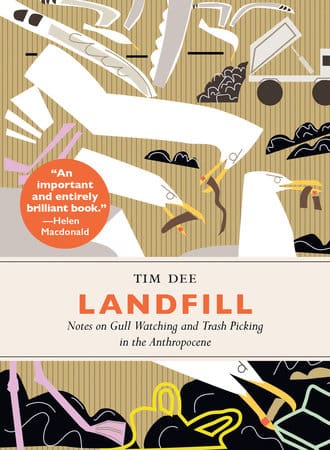Landfill
Notes on Gull Watching and Trash Picking in the Anthropocene
“There’s love and death here, fear, fascination, hope, and the breaking of the world. Dee has written an absolute triumph.”―Helen Macdonald, author of H Is for Hawk
Over the past hundred years, gulls have been brought ashore by modernity. They now live not only on the coasts but in our slipstream following trawlers, barges, and garbage trucks. They are more our contemporaries than most birds, living their wild lives among us in towns and cities. In many ways they live as we do, walking the built-up world and grabbing a bite where they can. Yet this disturbs us. We’ve started fearing gulls for getting good at being among us. We see them as scavengers, not entrepreneurs; ocean-going aliens, not refugees. They are too big for the world they have entered. Their story is our story too.
Landfill is the original and compelling story of how in the Anthropocene we have learned about the natural world, named and catalogued it, and then colonized it, planted it, or filled it with our junk. While most other birds have gone in the opposite direction, hiding away from us, some vanishing forever, gulls continue to tell us how the wild can share our world. For these reasons Landfill is the nature book for our times, groundbreaking and genre-bending. Without nostalgia or eulogy, it kicks beneath the littered surface of the things to discover stranger truths.
“In his delightful jaunt through gull taxonomy, behavior, and lore, Tim Dee casts his feathered protagonists as indomitable heroes of the Anthropocene―thriving in our cities, colonizing our culture, and repurposing our trash as treasure. Next time a gull snatches your fries, you’ll find yourself not cursing a petty thief, but admiring one of our planet’s grittiest, savviest survivors.”―Ben Goldfarb, author of Eager and Crossings
Reviews & Praise
“Landfill is an important and entirely brilliant book. It’s a love letter to gulls and their charged relationship with humans, but it’s also a deep meditation on difficulty and waste, on the beauty of the disregarded, and on what we make of matter out of place. There’s love and death here, fear, fascination, hope, and the breaking of the world. Dee has written an absolute triumph.”―Helen Macdonald, author of H Is for Hawk
“The British literature of birds that includes Gilbert White with his swifts and martins, Helen Macdonald with her hawks, is a rich one. But Tim Dee’s own obsession with gulls also leads him to contemplate the landfills over which they often preside and the alarming changes to our landscapes with which they are associated. His alertness to factors in ecological health results not in a jeremiad, however, but instead in an exploration of surprising parallels between evolution in the biological realm and the slow siftings of memory and culture. Landfill is a remarkably venturesome, robustly voiced, and illuminating book.”―John Elder, author of Reading the Mountains of Home
“Like coyotes, ravens, raccoons, and other resourceful urban wildlife, gulls frequently face our scorn, and sometimes our bullets. In his delightful jaunt through gull taxonomy, behavior, and lore, Tim Dee casts his feathered protagonists as indomitable heroes of the Anthropocene―thriving in our cities, colonizing our culture, and repurposing our trash as treasure. Next time a gull snatches your fries, you’ll find yourself not cursing a petty thief, but admiring one of our planet’s grittiest, savviest survivors.”―Ben Goldfarb, author of Eager and Crossings
“Tim Dee’s restive and gorgeous prose pulls readers into the wilds of the modern urban landscape, where gulls and humans wander side-by-side with ancient poets, Victorian novelists, and Madagascar nighthawks. In this small book Dee asks―and beautifully begins to answer―one of the largest questions of our time: How do we live with attentive grace and wisdom alongside the varied coinhabitants of our imperiled, complex, and beloved earth?”―Lyanda Lynn Haupt, author of Mozart’s Starling and Crow Planet
“Evolution is fluid, and the urban gulls of Tim Dee’s Landfill embody this ever-changing world in action. Tracking difficult-to-categorize gulls and the people who know their habits best, Dee alerts us to the heavy-laden meanings we lay on the wings of others, even as he revels the ways in which gulls continue to fly beyond our grasp. Familiarity need not breed contempt. As Dee shows, it can breed fascination.”―Gavin Van Horn, author of The Way of Coyote
“Dee’s book is a wonderfully thoughtful and gently ironic meditation on ‘gull-life and gulling-life,’ as well as our changing relationship with nature.”—The Guardian
“In Dee’s hands, a book about gulls becomes an exploration of the Anthropocene, a meditation on the taxonomic impulse and a philosophical inquiry into waste.”—New Statesman







